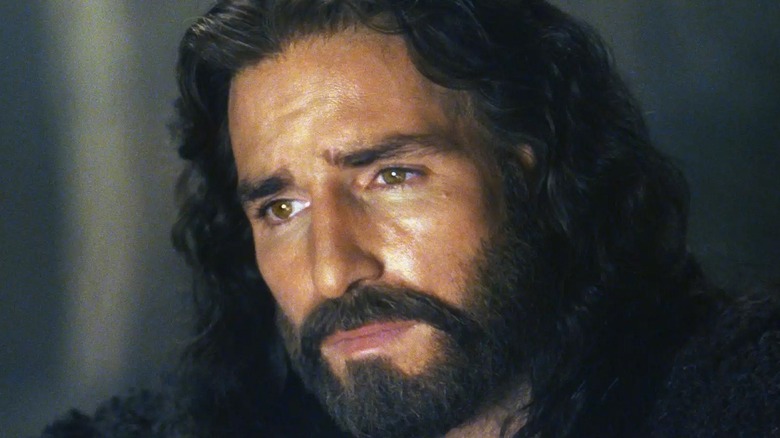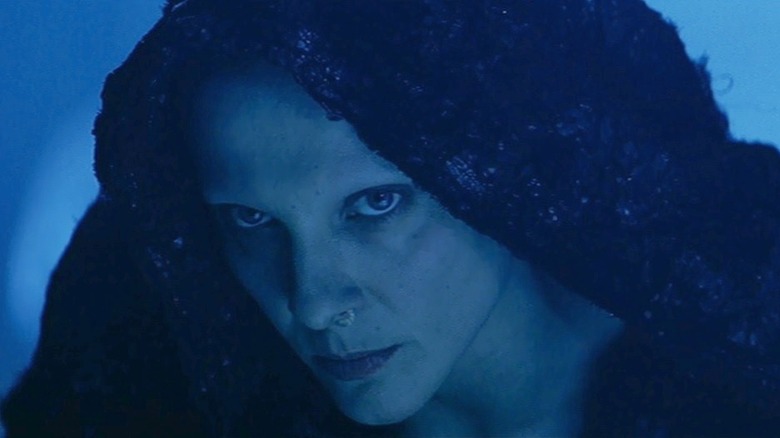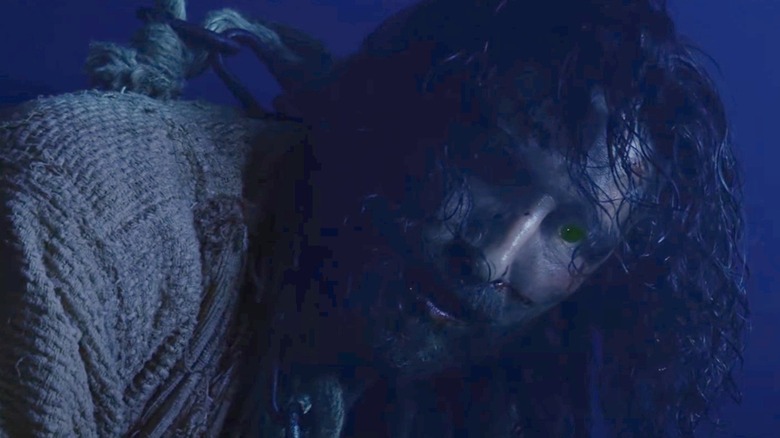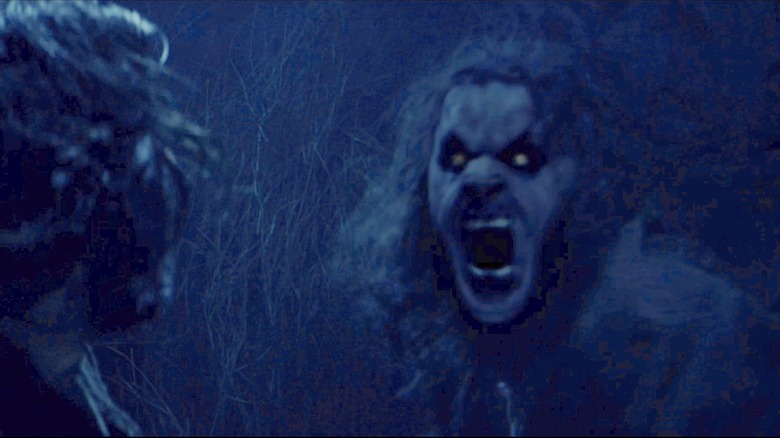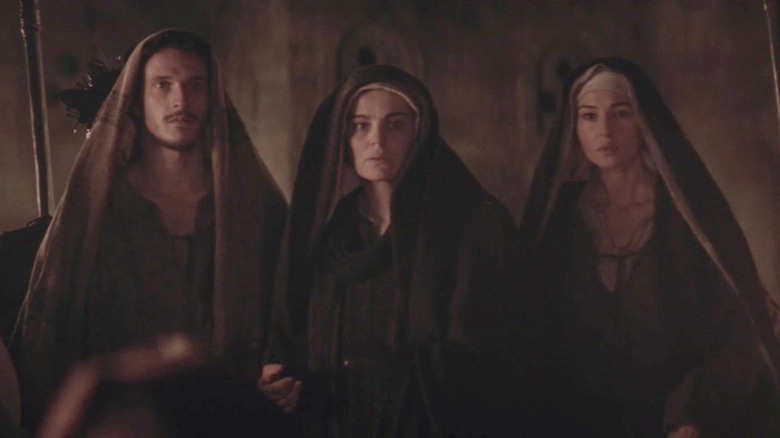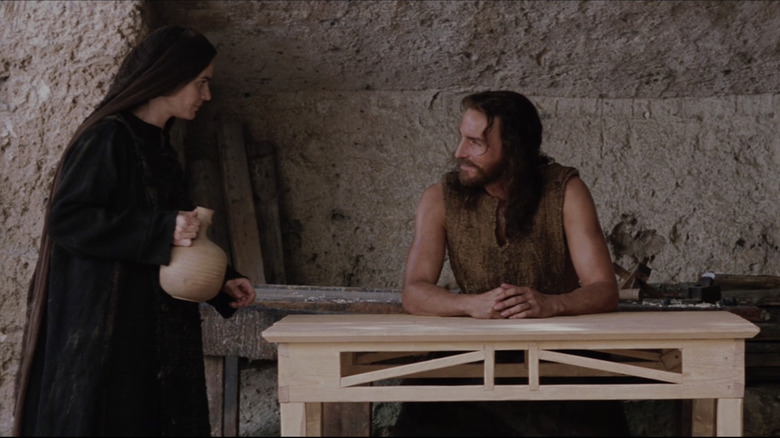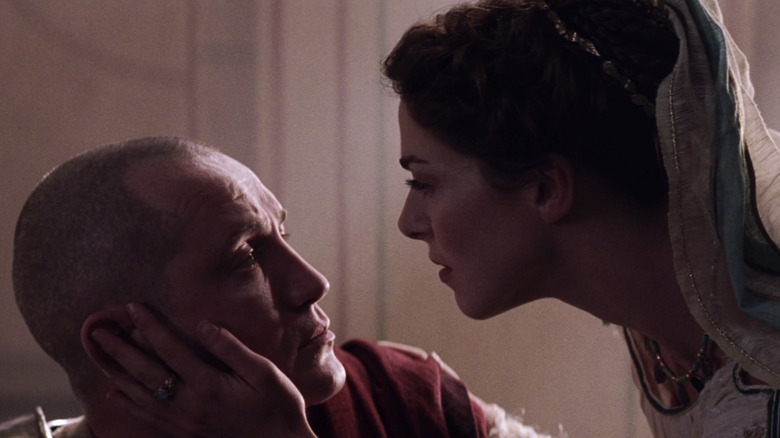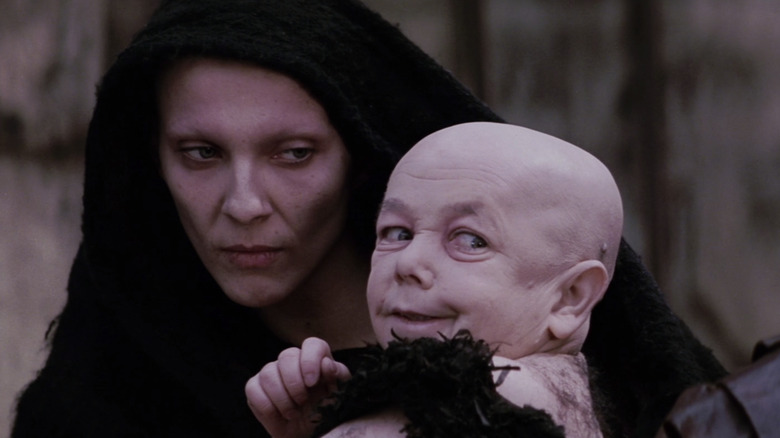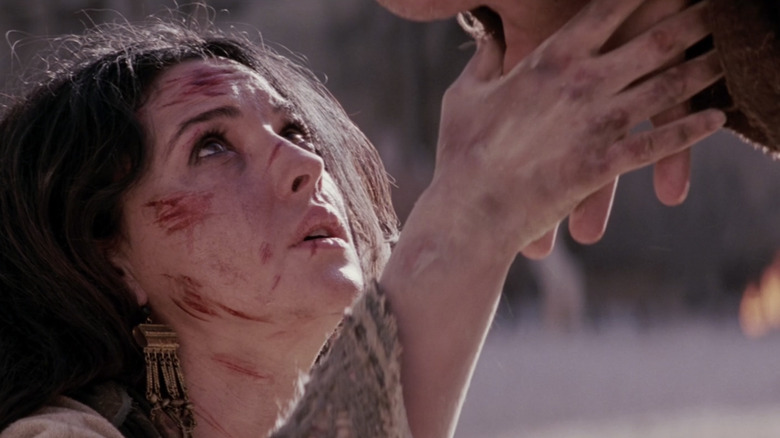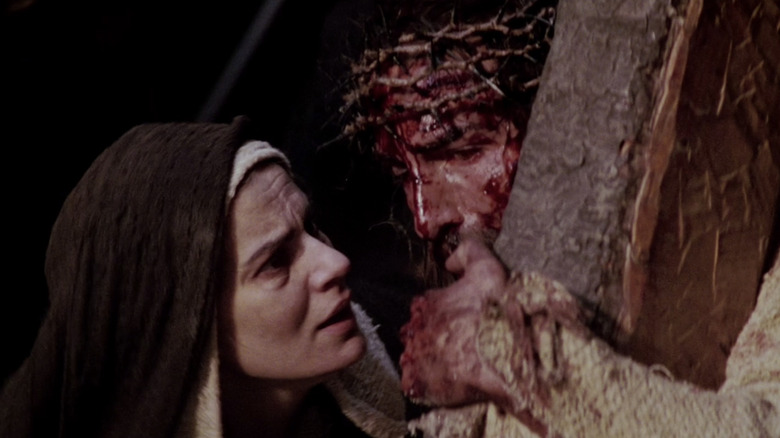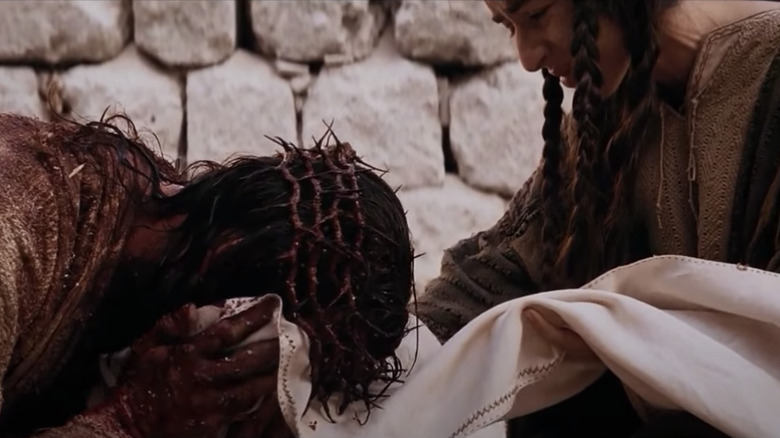The Passion Of The Christ Scenes That Aren't In The Bible
As possibly the most controversial religious film of our day, "The Passion of the Christ" is a filmmaking triumph that shows the genuine brutality of Roman crucifixion as well as the humanity of Jesus of Nazareth. Criticisms of the film's director Mel Gibson or star Jim Caviezel aside, there's no denying that, for many, watching "The Passion" is a deeply personal and especially humbling experience. As film critic Roger Ebert once put it, "This is not a sermon or a homily, but a visualization of the central event in the Christian religion. Take it or leave it." Whether you're religious or not, or if you're just interested in exceptional filmmaking, "The Passion of the Christ" is a must-see for folks everywhere, if not just for the transcendent and historical nature of the material.
Speaking of history, the film's dialogue is entirely in Hebrew, Latin, and Aramaic. While this sadly ignores the fact that the Romans would have actually spoken Greek, it represents Gibson and company's clear commitment to capturing the most compelling and unparalleled telling of Christ's final hours on film. Though the film is largely based on the four gospel accounts found in scripture, what some viewers might be unaware of is that not everything you see or hear on screen is actually recorded in the Bible. In fact, some of the artistic additions — many coming from Anne Catherine Emmerich's "The Dolorous Passion of Our Lord Jesus Christ" or Catholic tradition — have no biblical basis whatsoever.
Satan in the Garden of Gethsemane
Right off the bat, "Passion" introduces us to Jesus and his disciples via Christ's final plea to his heavenly father in the Garden of Gethsemane. It's here that Jesus is in deep prayer, to the point where he's actually sweating blood (note: that part is in the Bible), and asks God if there's any way that he could avoid going to the cross. It doesn't take too long for him to get his answer, but in the meantime he's stalked by a very creepy looking Satan, who tempts the messiah as he cries out to the heavens. From out of the devil, a snake appears and even nears Jesus before he crushes its head (a direct reference to Genesis 3:15).
As far as the gospel accounts are concerned, Satan doesn't appear in Gethsemane at all. Earlier in the gospels, at the beginning of his ministry, Christ was tempted by Satan in the wilderness for 40 days (told in Matthew 4:1-11, Mark 1:12-13, and Luke 4:1-13), but eventually the devil left him behind. Well, at least for a time. In Matthew 16:21-23, the fallen angel returns to try to ensnare the apostle Peter, but Jesus rebukes him then, too. It isn't until the Last Supper that Satan will "enter into" Judas Iscariot, sparking the events of "The Passion" (Luke 22:3 and John 13:27).
Jesus thrown off a bridge
After Jesus is taken by the Temple Guards (who seem to be the same soldiers sent by the chief priests in John 18:1-3), he is paraded across Jerusalem to meet with the high priest Caiaphas, the Pharisees, the scribes, and Jewish elders. Along the way, the temple guards beat him, and they eventually throw him over a bridge before pulling him back up to beat him some more. While the gruesome nature of the film is intentional, this scene is noteworthy because of the brief moment that Jesus and Judas Iscariot share together at the bottom of the bridge (where Christ's betrayer is hiding). As Jesus looks into the traitor's eyes, we see a tormented Judas, who is remorseful of his part in it.
Of course, this scene is nowhere to be found in scripture, nor is there anything like it even alluded to in any of the four gospels. We do know that many of the other scenes Judas appears in — his two meetings with the Pharisees, his betrayal of Jesus, and his hanging in the "Field of Blood" (which omits the graphic nature of his death as told in Acts 1:18) — all come directly from the biblical accounts. However, this final confrontation between Christ and his former disciple is a work of pure fiction.
Judas tormented by Demons
Speaking of the same scene, at the end of the confrontation between Jesus and Judas under the bridge, Iscariot is confronted by a demon, which sets off a chain of events throughout the rest of his time on screen. It's in his next few scenes that the former disciple is tormented by demons everywhere, first by a single frightening demon then by demonic children, before dying by suicide. These evil spirits are clear representations of Judas' own grief, fear, and remorse, but ultimately the former disciple never repents of his actions, instead succumbing to his own inner demons.
While the Bible never says that Judas Iscariot was tormented by demons following his betrayal of Christ, it doesn't seem like too much of a stretch. In fact, there's actually biblical precedent for it given that scripture says Satan himself entered Judas before he betrayed his former rabbi (Luke 22:3 and John 13:27). It also says that Satan's ultimate goal is to "steal, kill, and destroy," (John 10:10) and this all falls within those parameters. Though "The Passion of the Christ" obviously uses some artistic license to expand on Judas Iscariot's story, it's not altogether far-fetched.
If you or anyone you know is having suicidal thoughts, please call the National Suicide Prevention Lifeline at 1-800-273-TALK (8255).
John and the Marys at the trials
Throughout the film, the apostle John, Mary the mother of Jesus, and Mary Magdalene are seen as bystanders to the unfolding events of Jesus' trial, crucifixion, and ultimately his death. From the moment John tells the Marys about Jesus' arrest (which Mother Mary seems to already know about) to the moment Christ is removed from the cross, they're there every step of the way. While it's possible that they were there throughout each of the Stations of the Cross, the Bible only notes that they were there at the actual crucifixion (accompanied by Mary of Cleopas as well). "The Passion," on the other hand, keeps them as a consistent part of the story.
Many scenes regarding these three are included in "The Passion" that can't be found in scripture, but the biggest might be when the Marys clean Jesus' blood after he is flogged by the Roman soldiers. As John watches, they get on their hands and knees and wipe up the sacred element with cloths given to them by Pilate's wife (more on her in a minute). This, along with other scenes such as Mother Mary and Jesus' interactions during his trial and incarceration, are additions that, though they make sense in a narrative context, are nowhere to be found in the original text.
Mother Mary's Flashbacks
Possibly the movie's biggest divergence, Mary's flashback scene to Jesus building a wooden table (the same kind we would use now, but not at all like what they used in 1st century Israel). In this scene, he explains that he's building it and some chairs for a rich man, implying that the trend will catch on (wink-wink). While the scene is a nice nod to Jesus' omniscience as the son of God, it's not exactly scripture. While the Bible states that Jesus was in fact a carpenter (Mark 6:3), probably having learned from his earthly adoptive father Joseph (Matthew 13:55), we never actually get a glimpse of his work in the ancient texts themselves.
Out of all the film's extra-biblical content, this is the one that feels the most out of place and, well, a bit silly, too. Not that a nice, touching moment between mother and son isn't nice — it certainly is — but compared to the rest of the strictly biblically-based flashbacks we get in "The Passion," not to mention the other moments in the Bible that we could've flashed to (such as a young Jesus at the temple from Luke 2:41-52), this one is just odd.
Pontius Pilate and his wife
If "The Passion of the Christ" expands on any character, it's Pontius Pilate. A man we know little about from scripture (and a bit more about from history), Pilate is the one who orders the eventual crucifixion of Jesus after the hoards of Jewish people condemn the one-time messiah to death. Appearing in a few different scenes in the film, Pilate questions Jesus, asking him "what is truth?" while also hoping to release him after "finding no fault" in him. Unlike many other harsher interpretations of Pilate, this one is a bit more sympathetic, portraying him as a man trying to hold his precinct together rather than a bloodthirsty tyrant.
Pilate's wife, Claudia, on the other hand, gets a lot more to do here in "The Passion" than she does in any of the gospel accounts. While the film does accurately portray her initial scene with her husband, explaining her nightmare and that she should have nothing to do with Jesus' trial since he is a righteous man (Matthew 27:19). Afterwards, she continues to consult with her husband over the case, and even goes so far as to help the Marys by given them cloths to wipe up Christ's spilled blood. While these scenes aren't at all accurate to the scriptures, they might be a reference to the theory that the Claudia spoken of in 2 Timothy 4:21 is actually Pilate's wife, and that she did in fact become a Christian.
Satan with Jesus through his death
Mel Gibson's version of Satan doesn't just tempt Jesus at the Mount of Olives, but actually follows (stalks?) the messiah throughout his 12-hour ordeal, throughout most of the Stations of the Cross. Often watching Christ from the crowds, passing invisibly by various Jewish and Roman spectators, this dark specter taunts and teases the son of man through the entire film. Again, there's no mention in the Bible of Satan continuing to tempt Christ throughout the crucifixion process, but it's an artistic rendition that doesn't seem to be too far-fetched. We know from the Book of Job that Satan is an accuser who wanders the Earth, so maybe that's what the film was going for.
But the creepiest moment in the film is by far when Satan walks around carrying a demonic baby, which seems at first to be nursing from the fallen angel's chest. It's incredibly disturbing. The creepiness of it aside, it might possibly be a reference to the coming of the future antichrist of the Book of Revelation, or simply a corruption of the "Madonna" to spite Catholic and Orthodox traditions. Either way, it's incredibly unnerving. In Satan's final moments, post-Christ's death but before his resurrection, the Devil is seen screaming, recognizing that his supposed "win" was actually the greatest loss he could suffer. Although we don't see this in the Bible, Satan's defeat is referenced explicitly in 1 John 3:8, Hebrews 2:14-15, Colossians 1:13, and Romans 16:20.
Mary Magdalene as the woman caught in adultery
Okay, to be fair, this one isn't really the filmmakers' fault. There are plenty of scholars, theologians, and religious traditions that teach that Mary Magdalene was the woman who was caught in adultery, the same one Jesus refused to condemn (John 7:53-8:1–11). As the story goes, the woman is brought before Jesus by the religious leaders after being caught in an adulterous act, but rather than condemn her for her sin, Jesus asks the crowd who before him is "without sin" and can "cast the first stone." One by one, the crowd dissipates until Jesus is left alone with the woman. Rather than condemn her, he lets her go, commanding her to "go and sin no more."
While that story is one of the most powerful in all of scripture, Mary's part in it isn't ever explicitly stated. At other points in the gospels, such as Mark 16, it's said that Mary was a woman who Jesus had cast many demons out of, and Luke 8:2-3 even states that she was one of the women who traveled with Jesus and his disciples, helping to financially support his ministry, but nowhere does it actually claim she was an adulterous. While this was an obvious nod to general church tradition, it's based a more on theory rather than textual authenticity.
Mother Mary's part in The Passion
Although we mentioned mother Mary's role in "The Passion" earlier, including her flashback scenes with Jesus, the biggest artistic license given to this film is her part in the Stations of the Cross. The Bible says that Mary was a spectator at her son's crucifixion, overlooking the event with the apostle John, Mary Magdalene, and Mary of Cleopas, but it never mentions that she was there along the way. The moment in the film when Mother Mary helps Jesus stand back up to his feet while he's carrying his cross is certainly powerful, not to mention moving, but it's not all that accurate.
"The Passion of the Christ" really up-plays Mary's role in these biblical events. In Catholicism, and certain Orthodox traditions, mother Mary is elevated to a higher, more divine, status than most Christian denominations subscribe to, with veneration and prayers being offered to the "Blessed Virgin" as well as her son. While the Bible doesn't actually magnify Mary in this way (that's reserved for God alone), "The Passion" certainly seems to, and sometimes it's kind of distracting.
The addition of Saint Veronica
Another Catholic tradition that isn't found in the pages of scripture revolves around Saint Veronica. This Catholic saint is portrayed in "The Passion of the Christ" by actress Sabrina Impacciatore and only shows up for a single scene in which she mops the bloodied face of Christ with a towel — a Catholic relic known as the "Veil of Veronica." Before he's forcibly removed from Veronica's presence by the Roman soldiers, Jesus is shown a nigh-miraculous act of compassion by this devout follower, and one that has been remembered throughout Church history.
But as stated above, Saint Veronica doesn't appear in the Bible, nor does she show up at all in church history until around 1,000 years after Christ's crucifixion. Veronica was featured pretty heavily in Anne Catherine Emmerich's visions, collected as "The Dolorous Passion of Our Lord Jesus Christ," which heavily influenced Gibson's vision for "The Passion" in the first place and was arguably as important to the film's development as the gospel accounts themselves. We'll be interested to see what Gibson chooses to include in his upcoming sequel...
